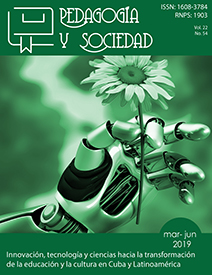APLICACIÓN DE LAS NEUROCIENCIAS EN LA ENSEÑANZA UNIVERSITARIA. CASO DE UNA LICENCIATURA EN EDUCACIÓN/APPLICATION OF NEUROSCIENCES IN UNIVERSITY EDUCATION CASE OF A DEGREE IN EDUCATION
Palabras clave:
Docente eficaz, neuroeducación, neurociencias, universidadResumen
RESUMEN
El objetivo de esta investigación es describir las aportaciones de las neurociencias que se aplican en la enseñanza, en una licenciatura en Ciencias de la Educación de una universidad pública del Estado de Sonora, México. Es un estudio cualitativo fenomenológico. Participaron 31 estudiantes el 55% del género femenino y el otro 45% del masculino. Se empleó una guía de tópicos para que los estudiantes describieran por medio de la técnica de composición escrita, el tema fue: actividades que realizan los buenos docentes. Se usaron hojas doble carta que contenían una tabla con siete recuadros, cada uno en una columna con el nombre de cada uno de los siete pasos para una clase cerebralmente amigable de Rosler (2015). Lo anterior para agrupar las respuestas dadas por los estudiantes. Se identificó que los docentes, aplican tres pasos de siete, lo que representa el 42% de aplicación. Los tres pasos que presentaron mayor peso semántico son: Abrir la memoria sensorial, Practicar y Fortalecer, los de menor peso semántico es el de Repasar y el de Reflexionar, los pasos que no presentaron ninguna cita fueron Decodificar y Recuperar.
Palabras clave: Docente eficaz; neuroeducación; neurociencias; universidad.
ABSTRACT
The objective of this research is to describe the contributions of the neurosciences that are applied in teaching, in a degree in Educational Sciences of a public university of the State of Sonora, Mexico. It is a qualitative phenomenological study. 31 students participated, 55% female and the other 45% male. A topic guide was used for the students to describe, through the technique of written composition, the theme was: activities that good teachers do. Double letter sheets were used that contained a table with seven boxes, each in a column with the name of each of the seven steps for a cerebrally friendly class of Rosler (2015). The above to group the answers given by the students. It was identified that teachers apply three steps of seven, which represents 42% of application. The three steps that presented the greatest semantic weight are: Open the sensory memory, Practice and Strengthen, those with the least semantic weight is the Revise and the Reflect, the steps that did not present any appointment were Decode and Recover.
Keywords: Effective teacher, neuroeducation, neurosciences, university.




_(Custom).jpg)





